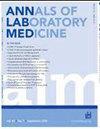使用靶向和非靶向方法检测外显子水平拷贝数变异的高分辨率染色体微阵列诊断潜力。
IF 3.9
2区 医学
Q1 MEDICAL LABORATORY TECHNOLOGY
引用次数: 0
摘要
拷贝数变异(CNVs)在人类遗传疾病中起着重要作用。检测外显子水平的CNVs对于准确的临床诊断至关重要。CytoScan XON阵列是一种高分辨率的微阵列,最近被开发用于检测各种基因的外显子CNVs。方法使用59例已鉴定出CNVs的患者样本,通过多重连接依赖探针扩增(MLPA)、基因剂量PCR和mRNA测定等方法进行验证,评估CytoScan XON Array的临床性能。在目标区域评估了CytoScan XON和正交方法之间的一致性,并通过分析非目标基因组区域的假阳性CNV,比较了基于基因组测序(GS)的CNV调用工具的诊断效用。结果对于目标区域,CytoScan XON阵列在所有CNV呼叫的外显子和基因水平上分别获得了89.8%和92.5%的一致性。多外显子CNVs的一致性(100%)高于单外显子CNVs (82.6%, P =0.03)。对于非目标区域,通过过滤策略,假阳性CNV呼叫减少到每个基因低于0.01。该阵列在剂量敏感基因内的假阳性检出率与基于gs的工具相当。结论CytoScan XON Array是检测靶区外显子水平CNV的可靠工具,可作为基于gs的CNV调用工具的补充方法,用于高分辨率的全基因组CNV筛选。然而,它在单外显子CNVs中的性能需要进一步优化。建议使用基于gs的CNV调用工具进行交叉验证,以提高诊断准确性。本文章由计算机程序翻译,如有差异,请以英文原文为准。
High-resolution Chromosomal Microarray with Diagnostic Potential for Detecting Exon-level Copy Number Variations Using Targeted and Non-targeted Approaches.
Background
Copy number variations (CNVs) play an important role in human genetic disorders. Detection of exon-level CNVs is crucial for accurate clinical diagnosis. The CytoScan XON Array, a high-resolution microarray, was recently developed to detect exonic CNVs of various genes.
Methods
We evaluated the clinical performance of the CytoScan XON Array using 59 patient samples with previously identified CNVs, confirmed via methods including multiple ligation-dependent probe amplification (MLPA), gene-dose PCR, and mRNA assay. Concordance between CytoScan XON and orthogonal methods was evaluated in target regions, and diagnostic utility was compared with that of genome sequencing (GS)-based CNV calling tools through analysis of false-positive CNVs in non-target genomic regions.
Results
For target regions, the CytoScan XON Array achieved concordance rates of 89.8% and 92.5% at the exon and gene levels, respectively, for all CNV calls. Concordance was higher for multi-exon CNVs (100%) than that for single-exon CNVs (82.6%, P =0.03). For non-target regions, false-positive CNV calls were reduced to fewer than 0.01 per gene per person through filtering strategies. The array exhibited false-positive detection rates within dosage-sensitive genes comparable with those of GS-based tools.
Conclusions
The CytoScan XON Array, a reliable tool for detecting exon-level CNVs in target regions, can serve as a complementary approach to GS-based CNV calling tools for genome-wide CNV screening with high resolution. However, its performance for single-exon CNVs requires further optimization. Cross-validation with GS-based CNV calling tools is recommended to improve diagnostic accuracy.
求助全文
通过发布文献求助,成功后即可免费获取论文全文。
去求助
来源期刊

Annals of Laboratory Medicine
MEDICAL LABORATORY TECHNOLOGY-
CiteScore
8.30
自引率
12.20%
发文量
100
审稿时长
6-12 weeks
期刊介绍:
Annals of Laboratory Medicine is the official journal of Korean Society for Laboratory Medicine. The journal title has been recently changed from the Korean Journal of Laboratory Medicine (ISSN, 1598-6535) from the January issue of 2012. The JCR 2017 Impact factor of Ann Lab Med was 1.916.
 求助内容:
求助内容: 应助结果提醒方式:
应助结果提醒方式:


